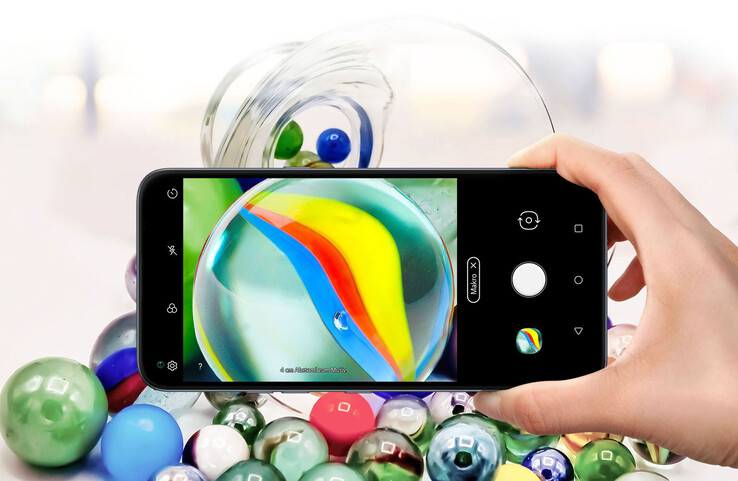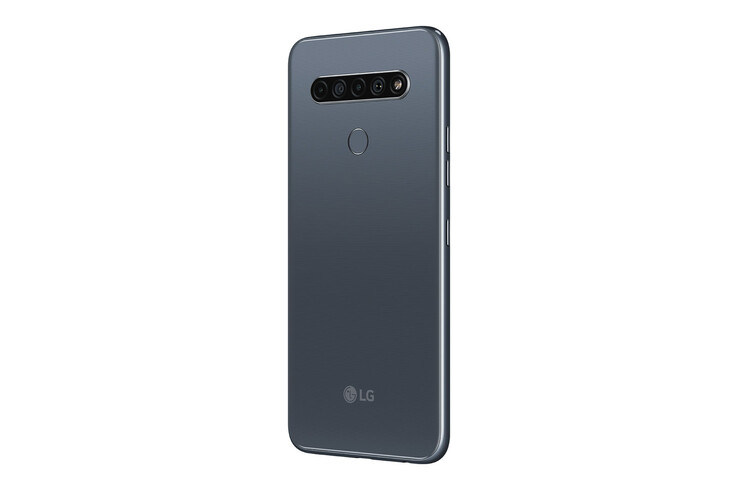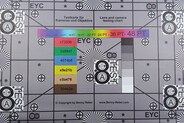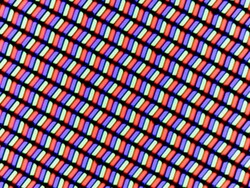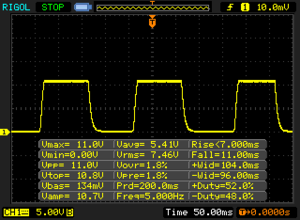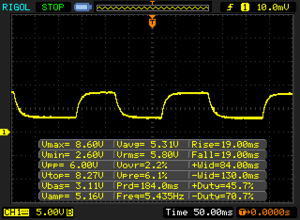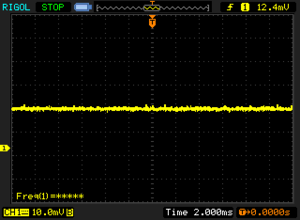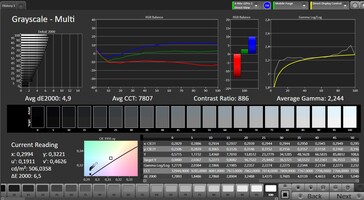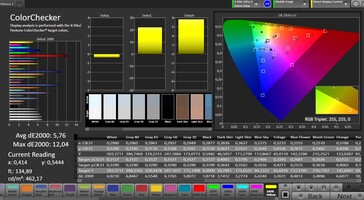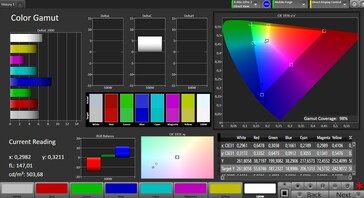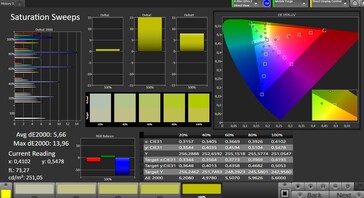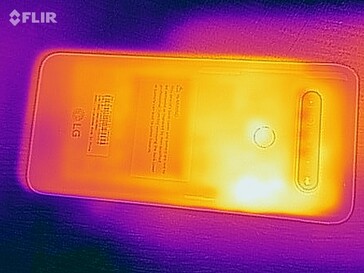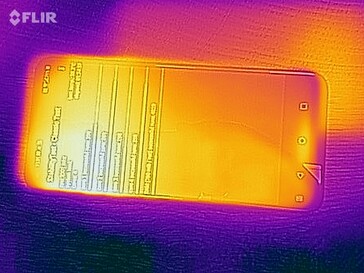LG K61 smartphone review - This LG cell phone is too old-fashioned
Comparison devices
Bewertung | Rating Version | Datum | Modell | Gewicht | Laufwerk | Groesse | Aufloesung | Preis ab |
|---|---|---|---|---|---|---|---|---|
| 74 % v7 (old) | v7 (old) | 09 / 2020 | LG K61 Helio P35 MT6765, PowerVR GE8320 | 191 g | 128 GB eMMC Flash | 6.53" | 2340x1080 | |
| 77.3 % v7 (old) | v7 (old) | 08 / 2020 | Oppo A72 SD 665, Adreno 610 | 192 g | 128 GB UFS 2.1 Flash | 6.50" | 2400x1080 | |
| 82.9 % v7 (old) | v7 (old) | 06 / 2020 | Xiaomi Redmi Note 9 Pro SD 720G, Adreno 618 | 209 g | 64 GB UFS 2.0 Flash | 6.67" | 2400x1080 | |
| 78.8 % v7 (old) | v7 (old) | 06 / 2020 | Samsung Galaxy A41 Helio P65, Mali-G52 MP2 | 152 g | 64 GB eMMC Flash | 6.10" | 2400x1080 |
Case, equipment and operation - chic, but slow
In white or grey, the LG K61 comes to your home, both versions have a subtle stripe pattern. The transverse camera module is an eye-catcher, on the front there is a slightly wider frame under the display, otherwise the smartphone looks quite modern thanks to the punchhole front camera. In terms of weight, the LG K61 is on the usual level for a smartphone of this size.
The material transitions are a bit rough from time to time, but overall the smartphone makes a solidly processed impression. With 128 GB mass storage, the equipment is quite lavish, and there is also NFC, so that you can use Google Pay.
It's a pity that the LG K61 only includes a WLAN module with WiFi 4, so the transfer rates that we measure with the reference router Netgear Nighthawk AX12 are significantly lower than the comparable devices with WiFi 5.
| Networking | |
| iperf3 transmit AX12 | |
| Xiaomi Redmi Note 9 Pro | |
| Samsung Galaxy A41 | |
| Oppo A72 | |
| LG K61 | |
| iperf3 receive AX12 | |
| Xiaomi Redmi Note 9 Pro | |
| Samsung Galaxy A41 | |
| Oppo A72 | |
| LG K61 | |
Cameras - 4 unsharp lenses
The camera module on the rear of the camera comes with four lenses. In addition to the main camera, there are significantly lower-resolution lenses for wide-angle and macro photography and a lens for depth-of-field effects.
Shots taken with the main camera appear brighter at first, but are not very detailed and look blurred when you look closer. The wide-angle camera corrects distortion rather moderately well, does not separate objects well from each other, and also takes rather blurred pictures in detail. For snapshots both lenses are suitable, but you shouldn't demand more from them. In low light, the brightening is quite good, but the autofocus fails, so that the pictures look very blurred.
Videos can be recorded with 1080p and 30 fps at most. The quality is similar to photos, i.e. in detail rather blurred, but the exposure even in darker areas is OK.
Image comparison
Choose a scene and navigate within the first image. One click changes the position on touchscreens. One click on the zoomed-in image opens the original in a new window. The first image shows the scaled photograph of the test device.
Hauptobjektiv BlumeHauptobjektiv UmgebungHauptobjektiv Low LightUltraweitwinkel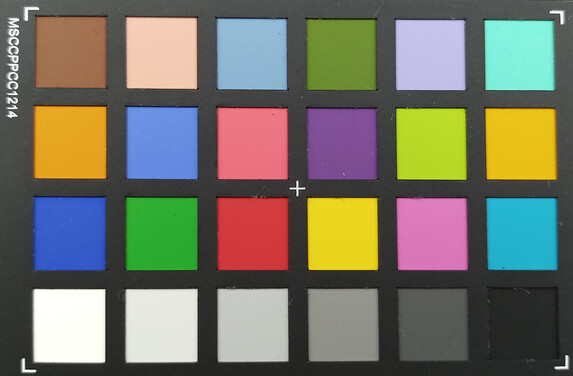
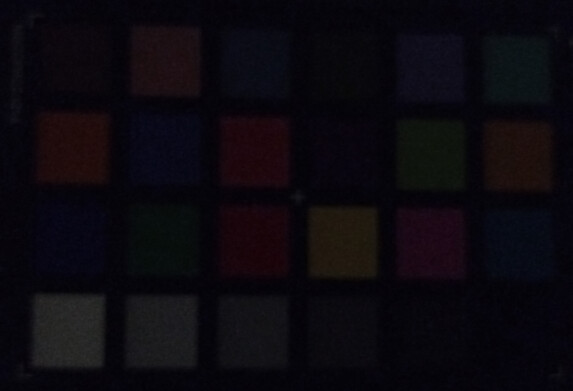
Display - Full-HD-Screen on the LG K61
A Full-HD display is now standard in this price class, and the LG K61 can also serve with it. The brightness is absolutely OK, but in comparison on a rather low level. The contrast remains below 1.000:1 due to the mediocre black level of 0.56 cd/m², which makes colors look less bright on the display.
We don't notice any PWM flickering, the response times of the screen are mediocre at best, but the smartphone is only suitable for gaming to a limited extent anyway due to the low performance.
There are also cell phones in this price range with more exact colors, especially strong red is reproduced falsified.
| |||||||||||||||||||||||||
Brightness Distribution: 95 %
Center on Battery: 505 cd/m²
Contrast: 902:1 (Black: 0.56 cd/m²)
ΔE ColorChecker Calman: 5.76 | ∀{0.5-29.43 Ø4.78}
ΔE Greyscale Calman: 4.9 | ∀{0.09-98 Ø5}
98% sRGB (Calman 2D)
Gamma: 2.244
CCT: 7807 K
| LG K61 IPS, 2340x1080, 6.5" | Oppo A72 IPS LCD, 2400x1080, 6.5" | Xiaomi Redmi Note 9 Pro IPS, 2400x1080, 6.7" | Samsung Galaxy A41 Super AMOLED, 2400x1080, 6.1" | |
|---|---|---|---|---|
| Response Times | -15% | -30% | 84% | |
| Response Time Grey 50% / Grey 80% * (ms) | 38 ? | 40.4 ? -6% | 44.8 ? -18% | 5.6 ? 85% |
| Response Time Black / White * (ms) | 18 ? | 22.4 ? -24% | 25.6 ? -42% | 3.2 ? 82% |
| PWM Frequency (Hz) | 2404 ? | 245.1 ? | ||
| Screen | -5% | 43% | 31% | |
| Brightness middle (cd/m²) | 505 | 505 0% | 610 21% | 554 10% |
| Brightness (cd/m²) | 511 | 482 -6% | 579 13% | 559 9% |
| Brightness Distribution (%) | 95 | 93 -2% | 92 -3% | 92 -3% |
| Black Level * (cd/m²) | 0.56 | 0.55 2% | 0.37 34% | |
| Contrast (:1) | 902 | 918 2% | 1649 83% | |
| Colorchecker dE 2000 * | 5.76 | 6.3 -9% | 1.8 69% | 2 65% |
| Colorchecker dE 2000 max. * | 12.04 | 10.1 16% | 3 75% | 7.7 36% |
| Greyscale dE 2000 * | 4.9 | 6.8 -39% | 2.5 49% | 1.6 67% |
| Gamma | 2.244 98% | 2.29 96% | 2.31 95% | 2.11 104% |
| CCT | 7807 83% | 8161 80% | 6864 95% | 6589 99% |
| Total Average (Program / Settings) | -10% /
-7% | 7% /
28% | 58% /
44% |
* ... smaller is better
Display Response Times
| ↔ Response Time Black to White | ||
|---|---|---|
| 18 ms ... rise ↗ and fall ↘ combined | ↗ 7 ms rise | |
| ↘ 11 ms fall | ||
| The screen shows good response rates in our tests, but may be too slow for competitive gamers. In comparison, all tested devices range from 0.1 (minimum) to 240 (maximum) ms. » 39 % of all devices are better. This means that the measured response time is better than the average of all tested devices (20.2 ms). | ||
| ↔ Response Time 50% Grey to 80% Grey | ||
| 38 ms ... rise ↗ and fall ↘ combined | ↗ 19 ms rise | |
| ↘ 19 ms fall | ||
| The screen shows slow response rates in our tests and will be unsatisfactory for gamers. In comparison, all tested devices range from 0.165 (minimum) to 636 (maximum) ms. » 54 % of all devices are better. This means that the measured response time is worse than the average of all tested devices (31.6 ms). | ||
Screen Flickering / PWM (Pulse-Width Modulation)
| Screen flickering / PWM not detected | |||
In comparison: 53 % of all tested devices do not use PWM to dim the display. If PWM was detected, an average of 8108 (minimum: 5 - maximum: 343500) Hz was measured. | |||
Performance, emissions and battery life - Need more power
The MediaTek Helio P35 is not a performance miracle and with this SoC the LG K61 is clearly inferior to comparable devices in terms of performance. The microSD reader cuts a good figure with our reference memory card Toshiba Exceria Pro M501, but the internal memory is quite slow, so loading times are lengthy.
In terms of warming, you don't have to worry about the LG K61, it doesn't warm up critically even under maximum load. The small mono speaker on the lower edge doesn't get very loud and can hardly display low mids, but remains quite muffled even when singing and is altogether only suitable for emergencies.
From the 4.000-mAh-battery LG gets a good 14 hours of battery life, which is enough for 2 to 3 days without charging during normal use. However, the smartphone needs well over 2 hours for a full battery, since there is no quick charge mode.
| PCMark for Android | |
| Work performance score (sort by value) | |
| LG K61 | |
| Oppo A72 | |
| Xiaomi Redmi Note 9 Pro | |
| Samsung Galaxy A41 | |
| Average Mediatek Helio P35 MT6765 (4040 - 7753, n=8) | |
| Work 2.0 performance score (sort by value) | |
| LG K61 | |
| Oppo A72 | |
| Oppo A72 | |
| Xiaomi Redmi Note 9 Pro | |
| Samsung Galaxy A41 | |
| Average Mediatek Helio P35 MT6765 (3814 - 5794, n=11) | |
| GFXBench | |
| on screen Aztec Ruins Normal Tier Onscreen (sort by value) | |
| LG K61 | |
| Oppo A72 | |
| Xiaomi Redmi Note 9 Pro | |
| Samsung Galaxy A41 | |
| Average Mediatek Helio P35 MT6765 (3.5 - 7.7, n=13) | |
| Average of class Smartphone (6.2 - 166, n=209, last 2 years) | |
| 1920x1080 Aztec Ruins Normal Tier Offscreen (sort by value) | |
| LG K61 | |
| Oppo A72 | |
| Xiaomi Redmi Note 9 Pro | |
| Samsung Galaxy A41 | |
| Average Mediatek Helio P35 MT6765 (3.8 - 4.3, n=13) | |
| Average of class Smartphone (3.4 - 367, n=209, last 2 years) | |
| on screen Aztec Ruins High Tier Onscreen (sort by value) | |
| LG K61 | |
| Oppo A72 | |
| Xiaomi Redmi Note 9 Pro | |
| Samsung Galaxy A41 | |
| Average Mediatek Helio P35 MT6765 (2.2 - 4.9, n=12) | |
| Average of class Smartphone (0.85 - 144, n=210, last 2 years) | |
| 2560x1440 Aztec Ruins High Tier Offscreen (sort by value) | |
| LG K61 | |
| Oppo A72 | |
| Xiaomi Redmi Note 9 Pro | |
| Samsung Galaxy A41 | |
| Average Mediatek Helio P35 MT6765 (1.4 - 1.6, n=12) | |
| Average of class Smartphone (1.2 - 146, n=209, last 2 years) | |
| LG K61 | Oppo A72 | Xiaomi Redmi Note 9 Pro | Samsung Galaxy A41 | Average 128 GB eMMC Flash | Average of class Smartphone | |
|---|---|---|---|---|---|---|
| AndroBench 3-5 | 190% | 147% | 83% | 62% | 1052% | |
| Sequential Read 256KB (MB/s) | 273.4 | 504 84% | 498.1 82% | 299.9 10% | 300 ? 10% | 2228 ? 715% |
| Sequential Write 256KB (MB/s) | 224.1 | 234.6 5% | 171.1 -24% | 211.1 -6% | 195.1 ? -13% | 1851 ? 726% |
| Random Read 4KB (MB/s) | 58.3 | 135.9 133% | 122.6 110% | 84 44% | 85.9 ? 47% | 296 ? 408% |
| Random Write 4KB (MB/s) | 13.7 | 152.9 1016% | 112.9 724% | 72.5 429% | 58.1 ? 324% | 337 ? 2360% |
| Sequential Read 256KB SDCard (MB/s) | 79.8 ? | 37.76 ? -53% | 76.7 ? -4% | 83 ? 4% | 78.1 ? -2% | |
| Sequential Write 256KB SDCard (MB/s) | 58.6 ? | 31.2 ? -47% | 54.9 ? -6% | 67 ? 14% | 61.8 ? 5% |
Temperature
(±) The maximum temperature on the upper side is 40.3 °C / 105 F, compared to the average of 35.2 °C / 95 F, ranging from 21.9 to 247 °C for the class Smartphone.
(+) The bottom heats up to a maximum of 38.3 °C / 101 F, compared to the average of 34 °C / 93 F
(+) In idle usage, the average temperature for the upper side is 26.2 °C / 79 F, compared to the device average of 32.9 °C / 91 F.
Speakers
LG K61 audio analysis
(±) | speaker loudness is average but good (79.6 dB)
Bass 100 - 315 Hz
(-) | nearly no bass - on average 60% lower than median
(+) | bass is linear (0% delta to prev. frequency)
Mids 400 - 2000 Hz
(-) | nearly no mids - on average 60% lower than median
(+) | mids are linear (0% delta to prev. frequency)
Highs 2 - 16 kHz
(-) | nearly no highs - on average 60% lower than median
(+) | highs are linear (0% delta to prev. frequency)
Overall 100 - 16.000 Hz
(-) | overall sound is not linear (129.6% difference to median)
Compared to same class
» 98% of all tested devices in this class were better, 2% similar, 0% worse
» The best had a delta of 11%, average was 35%, worst was 134%
Compared to all devices tested
» 99% of all tested devices were better, 1% similar, 0% worse
» The best had a delta of 4%, average was 24%, worst was 134%
Xiaomi Redmi Note 9 Pro audio analysis
(+) | speakers can play relatively loud (87.1 dB)
Bass 100 - 315 Hz
(-) | nearly no bass - on average 30.7% lower than median
(±) | linearity of bass is average (10.5% delta to prev. frequency)
Mids 400 - 2000 Hz
(+) | balanced mids - only 4.8% away from median
(+) | mids are linear (5.1% delta to prev. frequency)
Highs 2 - 16 kHz
(+) | balanced highs - only 3.4% away from median
(+) | highs are linear (4.3% delta to prev. frequency)
Overall 100 - 16.000 Hz
(±) | linearity of overall sound is average (20.2% difference to median)
Compared to same class
» 33% of all tested devices in this class were better, 9% similar, 58% worse
» The best had a delta of 11%, average was 35%, worst was 134%
Compared to all devices tested
» 52% of all tested devices were better, 8% similar, 40% worse
» The best had a delta of 4%, average was 24%, worst was 134%
Battery life
| LG K61 4000 mAh | Xiaomi Redmi Note 9 Pro 5020 mAh | Oppo A72 5000 mAh | Samsung Galaxy A41 3500 mAh | Average of class Smartphone | |
|---|---|---|---|---|---|
| Battery Runtime | |||||
| WiFi Websurfing (h) | 14 | 19.6 40% | 17 21% | 10.8 -23% | 19.3 ? 38% |
Pros
Cons
Verdict - There are good alternatives
LG should have made much more effort with the K61 to keep up with similarly expensive smartphones. Performance, WLAN speed, battery life, speaker quality, cameras: in none of these areas can the LG cell phone hold a candle to its competitors. Even at the now lower street price, you can often find better deals.
Although the housing of the LG K61 with the unusual camera module is pleasing, the device is altogether too old-fashioned.
This is a pity, because the housing pleases, the fingerprint sensor works reliably and for simple tasks the smartphone is sufficient in any case. But since the older Android 9 is also installed on the smartphone, it looks even more old-fashioned compared to the competition with more modern software.
The LG K61 could only be recommended if it was much cheaper, so there are better alternatives.
LG K61
- 09/15/2020 v7 (old)
Florian Schmitt




